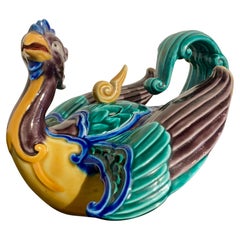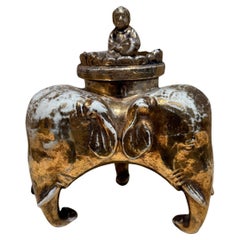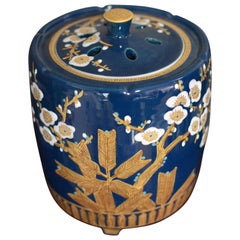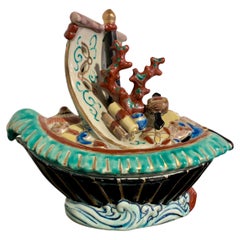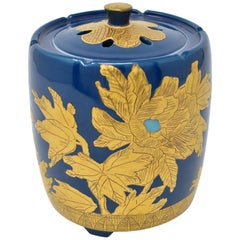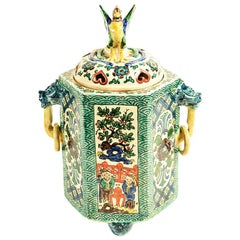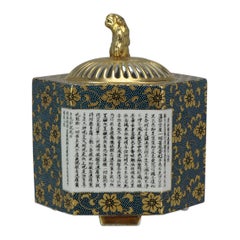Kutani Incense Burner
Vintage 1930s Japanese Showa Ceramics
Porcelain
Vintage 1940s Japanese Anglo-Japanese Decorative Boxes
Porcelain
21st Century and Contemporary Japanese Meiji Jars
Gold
Vintage 1910s Ceramics
Porcelain
21st Century and Contemporary Japanese Meiji Jars
Gold
Recent Sales
Antique 19th Century Japanese Ceramics
Pottery
20th Century Japanese Showa Ceramics
Porcelain
20th Century Japanese Anglo-Japanese Ceramics
Porcelain
Vintage 1930s Japanese Showa Ceramics
Porcelain
21st Century and Contemporary Japanese Jars
Gold
People Also Browsed
Antique 19th Century Japanese Qing Ceramics
Porcelain
Vintage 1910s Japanese Meiji Metalwork
Silver, Sterling Silver
Vintage 1930s Japanese Showa Ceramics
Porcelain
21st Century and Contemporary Japanese Meiji Jars
Gold
20th Century Chinese Qing Ceramics
Porcelain
Finding the Right Ceramics for You
With their rich and diverse history, antique, new and vintage Asian ceramics offer colorful and sophisticated ways to add flair to any space.
Japanese pottery dates back at least 13,000 years to the Jōmon period. Pieces from the Late Jōmon era display a rope-cord pattern encircling a pot or jug. During the Muromachi period, potters created simple bowls and utensils frequently used in tea ceremonies and were made as both functional and aesthetic objects.
Ceramics made during Japan’s Meiji period, from 1868 to 1912, reflected an explosion of artistic expression propelled by new access to international trade. Details became more intricate and refined, and colors were enhanced with new glazing practices.
Chinese porcelain, meanwhile, is often identified by its shape. Each reign and dynasty had specific shapes and styles that were encouraged by the imperial ruler. During the Song dynasty, for instance, there were four dominant types of ceramic vase shapes: plum-shaped, pear-shaped, cong-shaped (tall and square) and double-gourd.
Chinese ceramics that were made during the Qing dynasty were demonstrative of an expanded artistic expression, with more delicate shapes and a focus on intricate detailing. The shapes of ceramics from this era are thinner, taller and have subtle features like a gentle flare, such as on the mallet-shaped vase.
Later, the 17th- and 18th-century interior design trend of chinoiserie brought Asian paintings and screens, textiles and other art and furniture from the continent into many European homes.
Explore an extensive range of antique, new and vintage Asian ceramics on 1stDibs to find the perfect piece for your home.
- What are incense burners called?1 Answer1stDibs ExpertApril 5, 2022Incense burners go by a few different names; censer, thurible, perfume burner or a pastille burner. They’re all used for burning perfume in some solid form and vary in size, shape, appearance and purpose. They’ve often been used in religious ceremonies and for special occasions. Shop a range of antique and modern incense burners on 1stDibs.
- 1stDibs ExpertApril 5, 2022A Chinese incense burner, also called a censer, is a bowl made to hold burning incense. Censers were crafted from bronze, copper, porcelain or stone and often filled with dried aromatic plants and essential oils. Find an assortment of censers on 1stDibs.
- 1stDibs ExpertApril 5, 2022Flow incense burners work because of a hole drilled into incense cones. They direct the smoke produced by the cone downward, allowing it to form visually appealing plumes along the burners. On 1stDibs, shop a selection of antique and vintage incense burners.
- 1stDibs ExpertApril 5, 2022All incense burners work roughly the same, whether antique or contemporary. Usually the incense is placed inside the burner and lit, then a lid may be lowered, if there is one. The smoke will then filter out through holes in the lid. Shop a range of antique and modern incense burners on 1stDibs.
Read More
Symbols of Happiness and Rebirth Adorn This Japanese Satsuma Bowl
Decorated with white cranes and the sought-after thousand-butterflies motif, the Meiji-period vessel offers both a celebration of traditional aesthetics and a clear reflection of the era’s appetite for exquisite export pieces.
Chicago’s Pagoda Red Has a Spirited Mix of Asian Antiques and Bold New Art
For 25 years, gallerist Betsy Nathan has leveraged her keen eye and key connections to bring a unique selection of rare finds to the market.
In L.A., Gallerist JF Chen Has Long Championed Eclectic Blue-Chip Design
Now working alongside his daughter Bianca, dealer Joel Chen has presented a most covetable array of antiques, art and contemporary creations for more than 40 years.
12 Calming Spaces Inspired by Japanese Design
From cherry-blossom-adorned walls paired with glamorous lighting to wood-paneled ceilings above checkerboard-patterned chairs, these 12 spaces seamlessly blend Eastern and Western aesthetics.
Rodrigo Rivero Lake’s Mexico City Showroom Is a Museum-Worthy Trove of Spanish Colonial and Asian Antiques
The dealer and curator has spent the past 50 years amassing a collection of exceptional art, furniture and architectural elements that trace the cultural influence of the Spanish empire from Europe to the Americas and beyond.
16 Refined Asian-Inspired Interiors
These spaces exemplify how Eastern elements elevate a home's decor.
